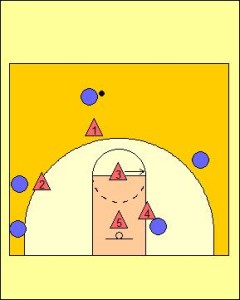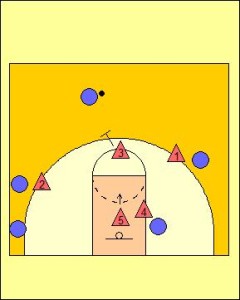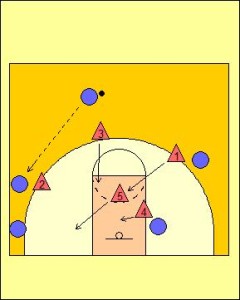I and 3 Junk Defence
The I and 3 Junk Defence is not very common, but can be very effective at providing a majority of players in man-to-man match-ups who are supported by the strength of zone help defence. One of the great benefits of the I and 3 Junk Defence is it allows for a number of different player placements to ensure players that are weak players defensively can be rotated into a variety of roles.
The I and 3 Junk Defence has a number of different options for defensive players to be positioned to make the most of their strengths or limit their weaknesses. The first option is to place your best individual defenders into the man-to-man match-up roles. This will place your weakest defenders into the roles of the zone defenders. This can be a useful strategy as these players’ defensive rotations and movement will be simplified.
The alternative to this strategy is especially beneficial if a team has a particularly effective shot blocker, charge taker, or general help defender. This player can be rotated into the zone “I formation” and then they can be more involved in help defence roles so often limited by standard player rotations in man-to-man defence.
The I and 3 Junk Defence has the bulk of the players in man-to-man match-ups. Because there are some many players playing this type of defence, usually they assume normal off the ball defensive rotations. So therefore, these players will rotate into normal help defence positions as the ball moves away from their match-up. This is different to other junk defences such as the Box and 1 or the Triangle and 2.

The two players forming the zone in the I and 3 Junk Defence start in an “I formation”. One player starts at the foul line with the other defender starting on the front of the rim.
When the ball is rotated to the wing, these players fill the high hole (strong side high post) and the other players fills the low hole (strong side low post). If one of these players has to rotate to guard the ball at any stage, the rule is that the low hole must always be filled to protect the basket.
The scenario depicted in the diagram above is when the ball is being guarded by one of the players in the man-to-man match-up roles. In this situation, the two zone players in the I and 3 Junk Defence are in the keyway.
If a player who is not being guarded with man-to-man principles should move into a position of being one pass away from the ball (as in the diagram for Three). Then the player can move towards this offensive match-up, but should never be in a denial position. At the most this player can have one foot outside of the keyway.
It should never be forgotten that the reason a team would use the I and 3 Junk Defence is because there are three players on the offensive team who dominate their team’s offense. The other two players should at best, be limited role players and therefore the defensive team is playing the odds that these players will not be able to fill the points which are limited in the others players. The role of the zone defence players is to provide strong help defence to the three players playing man-to-man principles.
The defensive team essentially wants the two weakest players to believe they have the shot and take it. As long as these shots are contested and from outside the key, this is the ideal situation.

In the diagram above of the I and 3 Junk Defence, it is the zone players who must pick up the ball in defence. Because this is a zone defence and the nature of the offensive players who will be guarded by the two defensive players in the zone, the top player (Three) should not extend to outside the three-point line.
Five (5) moves slightly up the split line to provide quicker help defence if required.
All other players just adjust (if required) to the position of the ball relevant to standard man-to-man defence principles.
When a shot is taken, it is important the players who form the zone formation continue to box-out.

During the I and 3 Junk Defence when the ball is passed to the wing both zone players must rotate quickly to fill the high and low holes.
On a pass to the player on the wing that is involved in a man-to-man match-up, it would be expected that the offensive player has some extreme heat placed on them. Two (2) depending on the scouting report should force the offensive player into a catch away from the basket.
On the flight of the ball Three (3) rotates off of the passer and into the high hole. Five (5) rotates to the low hole initially before hedging towards their likely match-up should the pass be pushed further down the sideline. Five (5) should remember though that their main role is in help defence for Two (2), not denying the player in the long corner of the ball.
Following standard man-to-man principles One (1) and Four (4) would move across to the split line.
Related articles








How do you beat this defense?
The best way to play against this defense is to look at where there is space on the court. Look to exploit this space with one of the players being covered by the zone defenders.
The other option here is to look at the defense operating more like a man-to-man defense then at zone defense. So a large percentage of standard offenses will work.
A weakness in this Offense is that the zones defenders can often forget about their responsibilities and receiver spots can be exploited.
The I and 3 plays very similar to a normal man to man defense. Therefore, it will breakdown in similar ways. For example, dribble penetration with movement to receiver spots will be effective. Dribble penetration with passes to the perimeter will foster good outside shots.